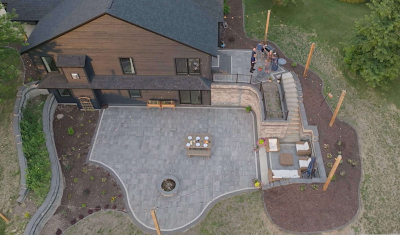If you're trying to maintain a lawn in Madison, either for a home or a residential property, we don't have to tell you it's a tricky business. Our weather can have extremes of temperature - sweltering in the summer, freezing in the winter - with some unusual properties to the soil as well. A great Madison lawn care service can help, but it's best to know some basic best practices for maintaining your own lawn.
So, let's dig into the topic and talk about the best ways to water and maintain your Madison lawn. This will help it stay looking great, in between visits from professional lawn care experts.
I. Understanding Wisconsin Soil and Water Properties
The amount of water that can be held by a particular kind of soil is called its holding capacity, or field capacity. This actually tends to come in layers, since soil is typically diverse as you move downwards. One layer of soil must reach its holding capacity before significant amounts of water can filter downward to the next layer.
This holding capacity varies depending on the type of soil, as well as how compacted it is. Sandy soil can hold much less water than clay, for example. So, it's important to know the type of soil you have, to gauge how much water to use.
In general, over-watering is less harmful than under-watering, but it can harm the lawn still.
II. Know Your Grass Root Depth
For grass to grow properly, its roots need to have access to nutrient-holding water throughout their length. This is something that's often overlooked, and it's why a person might have weak or withered grass despite frequent watering. If they aren't using enough water for it to penetrate all the way to the bottom of the grass's roots, the grass will still lack enough water.
There are many grass types being used around Wisconsin, but here's a quick guide to the root depth of some of the most common, in order of depth:
● Annual bluegrass: 1-4 inches
● Creeping bentgrass: 4-18 inches
● Colonial bentgrass: 9-18 inches
● Kentucky bluegrass: 9-30 inches
If you don't know what type of grass is on your lawn, a Madison lawn care service can quickly identify it for you, as well as investigate your soil type(s). This is vital information, particularly if you have grass with extensive root systems that need a lot of water to thrive.
III. The Impact of Madison's Climate on Watering
Madison's wide range of temperatures creates new problems for watering. Summer can quickly dry out your lawn, while the deep freeze of winter can cause ice to build up underground - especially if there's a surprise snap freeze, which we also see. Frequent wind will also dry out your lawn, although it's possible to use some greenscaping techniques to minimize the effect of wind on your lawn.
If you're in doubt about how dry your lawn is, just test it! This is simple to do, just take a small spade or trowel or similar sharp implement and push it into the ground, then pull it back out. You should be able to see the moisture on the blade, and it will also be easier to push through damp soil. Make sure to test this in several areas of your lawn too. Any sloping effects can concentrate water to a specific area of your yard.
If the top 3-4 inches are dry, it's certain that your lawn is too dry and it's time to add water.
IV. Other Madison Lawn Care Tips
1 - Water in the morning, or late at night
There's typically more wind in the afternoon and evening, so it's best to water your lawn outside of those times. You should also avoid watering during the middle of the day because you’ll experience more evaporation with the warmer temperature.
2 - Aerate your lawn once a year
Lawn aeration is the process of scooping small thin chunks of soil out of the lawn, so that it's easier for air, water, and nutrients to make their way to the lower levels of the root system. This is particularly helpful if you have dense soil, such as clay, which resists proper water penetration.
This solves runoff problems, as well as ensuring your lawn grows lush and green every year.
3 - Pay attention to your lawn quality
Your grass will tell you if it needs water! As grass dehydrates, first it becomes less resilient - it won't spring back up after you walk on it. Over time, the grass's color will also fade from a vibrant green to duller greens, yellows, and browns. Once it becomes brown, it's nearly dead.
Western Landscape Can Maintain Your Madison Lawn
If you're having difficulty keeping your Madison lawn happy and healthy, Western Landscape can help! We have years of experience helping homes and businesses keep their lawns looking amazing, with a variety of lawn care, aeration, planting, and green-scaping services.
Whether you just need regular lawn maintenance, or you're looking to reshape your lawn into something amazing, Western Landscape can make it happen. Contact us to learn more!





